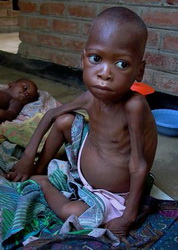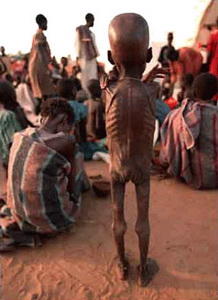
In the past, Vopus issued an official report about the money that is required to solve all the material problems of this humanity. The report included a comparison with the military budget of the countries all over the world. We publish it again at the end of this booklet.
All that is a crying hypocrisy, and that is why we publish today three more articles quoted from specialized Spanish magazines. We do not want to cry out to heaven but to the Consciousness of each one of us.
If that lie has spread worldwide, it is because the same lie exists inside each one of us, and exists in the same proportion.
We hope that these extraordinary articles impress us, and that we become conscious of our inner state.
We can do something for the people who are lacking the basic necessities of life (bread, dress and shelter). The old excuses such as "people suffer from hunger only in far poor places" are not true. Sometimes very near us, in any city, there are people undergoing needs. Not all needs are due to vices, games, alcohol... but also to lack of job, divorces, evictions, economic crisis, etc.
If you want to help, then, seek and you will find.
10 QUESTIONS
ABOUT THE HUNGER.

Still a fifth part of humanity suffers from hunger. And although each time there are less famines, however, malnutrition goes on killing more victims than great famines. Several associations, such as AICF, have initiated a campaign in order to explain and contribute solutions to this problem.
1.- Why are there over 800 million undernourished people?
With 20 million tons of cereals - the 10% of the worldwide stock -, half of the problem of malnutrition would be solved. This problem persists because of social causes such as poverty and growing inequalities among regions.
At present there are less famines than in the past, and the proportion of undernourished people has decreased; however the problem still continues to exist because of a deficient access to the distribution of the foods.
The resources of the world are wrongly distributed: The northern countries subsidize their agriculture, which produces more than is needed, while in the south there is hunger in countries that are self-sufficient in agriculture. For example, India has self-sufficiency of food and even exports foods, and at the same time, there are 70 million undernourished children in India, twice compared to all the Sub-Saharan Africa...
2.- Are we too many people and therefore we cannot be well-fed?
The population growth is a terrible threat because of the environmental effects that might derive from the incapacity of feeding the entire population. Currently there are 5,700 million people on the Earth, and population is growing to the rhythm of 97 million births every year. Reliable calculations say that there are resources to feed a worldwide population of 11,400 million, and this amount will be reached by the end of the next century, according to the most pessimistic demographers. Although in 30 years our planet has doubled its population, the vegetative growth tends to decrease slightly, and the production of cereals has grown a 40 %. In consequence, an equitable distribution of foods would provide 2,700 calories per person (the minimum is 2,200).
3.- Does the rise in population have influence in the situations of hunger?
In reality, it does not exist a direct connection between the population density and the level of nutrition. A very densely inhabited country is Indonesia, and it does not have problems of malnutrition because it has a dynamic agricultural sector. On the contrary, Zaire is an underpopulated country, but it has serious problems of nutrition. In consequence, most of the problem of malnutrition depends on the kind of agriculture that is practiced in that country. The combination of two factors, "the rise in population" and "the traditional systems of agriculture", ends up producing a lack of foods. A farmer from USA can feed up to 50 people, while a farmer from Africa harvests scarcely enough to feed his family.
4.- How is food distributed?
The access to the food depends on natural catastrophes, on catastrophes provoked by man -wars, deportations...- and on the purchasing power. Usually, poverty is caused by a low agricultural production and a weak purchasing power. The international donations of food do not contribute to solve the problem, so they should only applied in cases of emergency.
5.- How should we face up to malnutrition and famine?
Malnutrition consists basically in an unbalanced nutrition, both in quantity and quality, and in a difficult access to drinking water. The best way to solve malnutrition is with programs of development that contribute to improve the agricultural production and the sanitary and alimentary habits. Famine can be defined as a situation of violent hunger that quickly provokes a lot of dead. Fortunately, in the last quarter of century, famines have become more and more infrequent. Besides, they are short in time, easy to find, and entirely predictable. In these cases, the International Humanitarian Help or the Government's campaigns are the only measures that can reestablish the supply of food until the situation becomes stable.
6.- How can we solve malnutrition?

To put a patch on the problem does not solve it. Only exceptional situations justify the patches. The only way to eradicate hunger consists in promoting the sustainable development. Poverty decreases when the standard of living improves globally. By identifying the victims of malnutrition and taking specific actions, then half of this problem could be solved in two years.
7.- What means are the most effective?
Education influences decisively in the children's nutrition and in the birthrate. The women with a poor teaching have often more children. Afghanistan has a vegetative growth of 4 %, the highest in the world. It means that Afghanistan's population might double within 17 years.
For that reason, formative programs addressed to the women are necessary, so that women improve their social status, gain access to education, improve their knowledge about dietetics, and discrimination of the women has to be abolished. These measures plus the family planning will help to decrease the birthrate.
8.- Why do famines happen?
The weather conditions have every time less influence in the famines. Drought rarely provokes a period of hunger, unless it is combined with political and military interests as it has happened recently in Sudan. Famines usually happen in war zones, and start due to the idiocy or premeditation of the Governments or the fighting groups. The famines of Ethiopia (1,984) or Kenya (1,992) broke out due to the authorities' indolent attitude. Nowadays, the international organizations and the NGOs pay constant attention to the countries, and the famines are perfectly avoidable. Unfortunately, the hunger generates a lot of political and military benefits.

9.- Is it the best solution to produce more food?
Policies of agricultural modernization are necessary in order to step up the production of foods. However, this will be an effective solution only if these improvements promote the well-being of undernourished people, because the benefits usually go to the proprietors of the land and the investors. In addition, rich countries should help poor countries to abandon monoculture -because this practice make them depend on the international prices- and should help the industries of the Northern countries that settle down in the South to collaborate with the poorest social strata in order to cheapen the costs.
10.- Should production take priority over the environment?
The increase of the agricultural production does not imply the use of pesticides and other polluting techniques. The Administration USA has recognized that in the latest 20 years the damages to the harvests caused by the plagues has doubled, in spite of an increment of ten times in the use of pesticides.
On the other hand, a system of preventive information has allowed China to avoid the use of pesticides, and however, production has continued to grow and the cyclic famines have been eradicated from the most populated country of the orb.
There are many alternative solutions to produce more and preserve the ecological balance.

 |


